Sea Transport and International Trade
VerifiedAdded on 2023/06/13
|12
|2397
|301
AI Summary
This report analyzes the factors affecting sea freight rates and determines the equilibrium freight rate using demand and supply functions. It discusses the impact of freight rate variation on ship-owners in ordering or removing ships within the market. The report also explains the demand and supply concepts and how they operate in the maritime market.
Contribute Materials
Your contribution can guide someone’s learning journey. Share your
documents today.

Running head: SEA TRANSPORT AND INTERNATIONAL TRADE
Sea transport and international trade
Name of the student
Name of the university
Author Note
Sea transport and international trade
Name of the student
Name of the university
Author Note
Secure Best Marks with AI Grader
Need help grading? Try our AI Grader for instant feedback on your assignments.
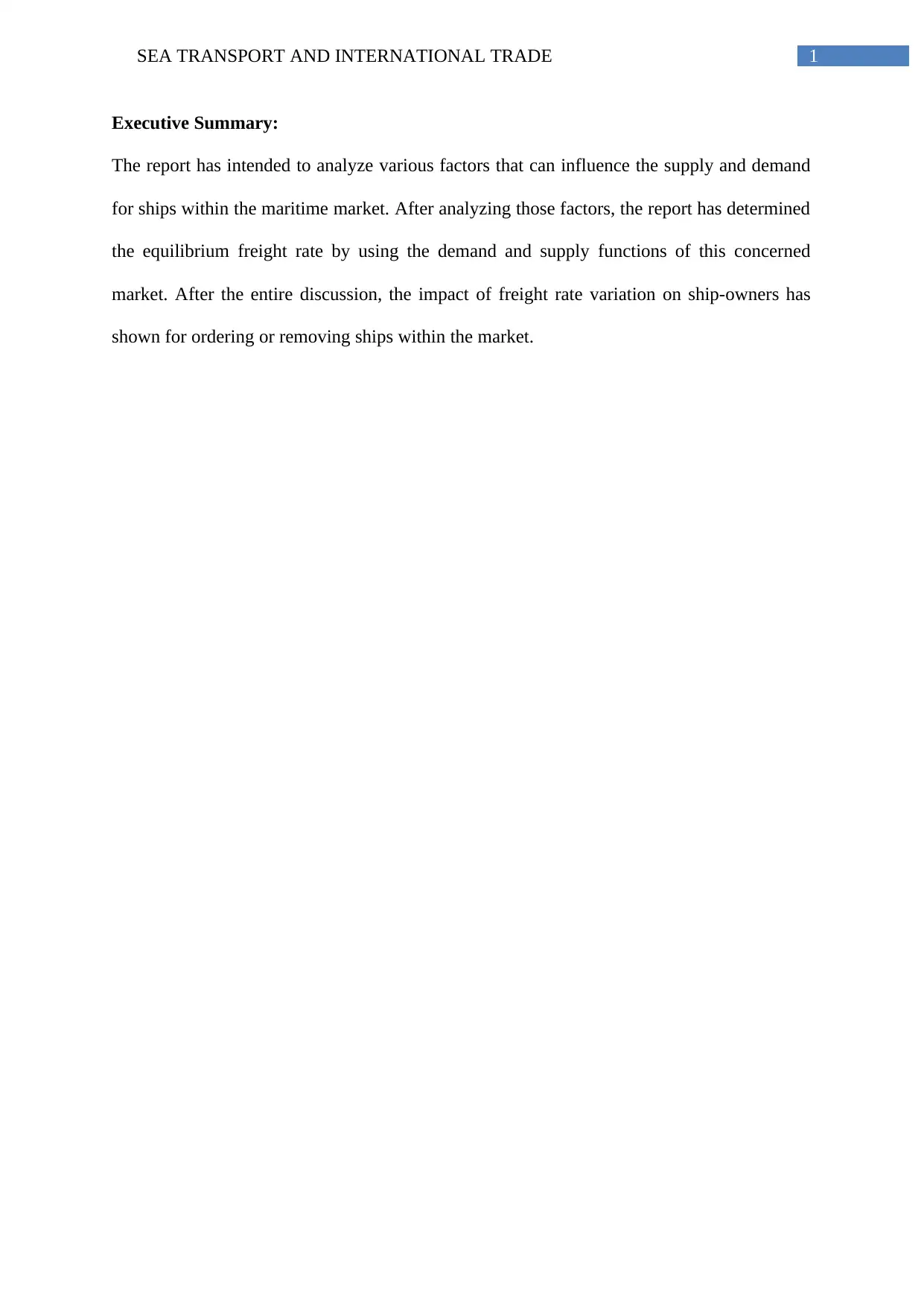
1SEA TRANSPORT AND INTERNATIONAL TRADE
Executive Summary:
The report has intended to analyze various factors that can influence the supply and demand
for ships within the maritime market. After analyzing those factors, the report has determined
the equilibrium freight rate by using the demand and supply functions of this concerned
market. After the entire discussion, the impact of freight rate variation on ship-owners has
shown for ordering or removing ships within the market.
Executive Summary:
The report has intended to analyze various factors that can influence the supply and demand
for ships within the maritime market. After analyzing those factors, the report has determined
the equilibrium freight rate by using the demand and supply functions of this concerned
market. After the entire discussion, the impact of freight rate variation on ship-owners has
shown for ordering or removing ships within the market.
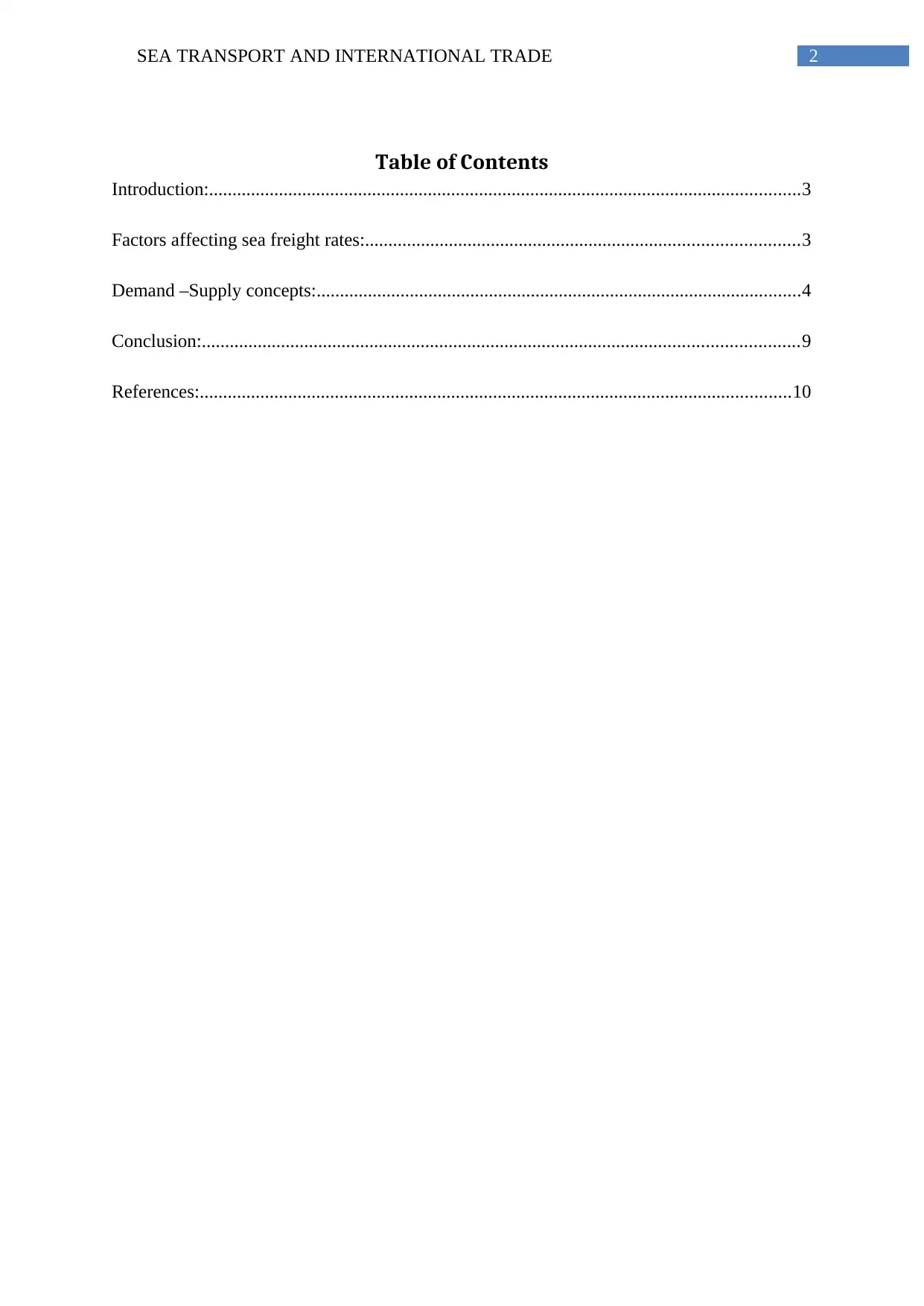
2SEA TRANSPORT AND INTERNATIONAL TRADE
Table of Contents
Introduction:...............................................................................................................................3
Factors affecting sea freight rates:.............................................................................................3
Demand –Supply concepts:........................................................................................................4
Conclusion:................................................................................................................................9
References:...............................................................................................................................10
Table of Contents
Introduction:...............................................................................................................................3
Factors affecting sea freight rates:.............................................................................................3
Demand –Supply concepts:........................................................................................................4
Conclusion:................................................................................................................................9
References:...............................................................................................................................10
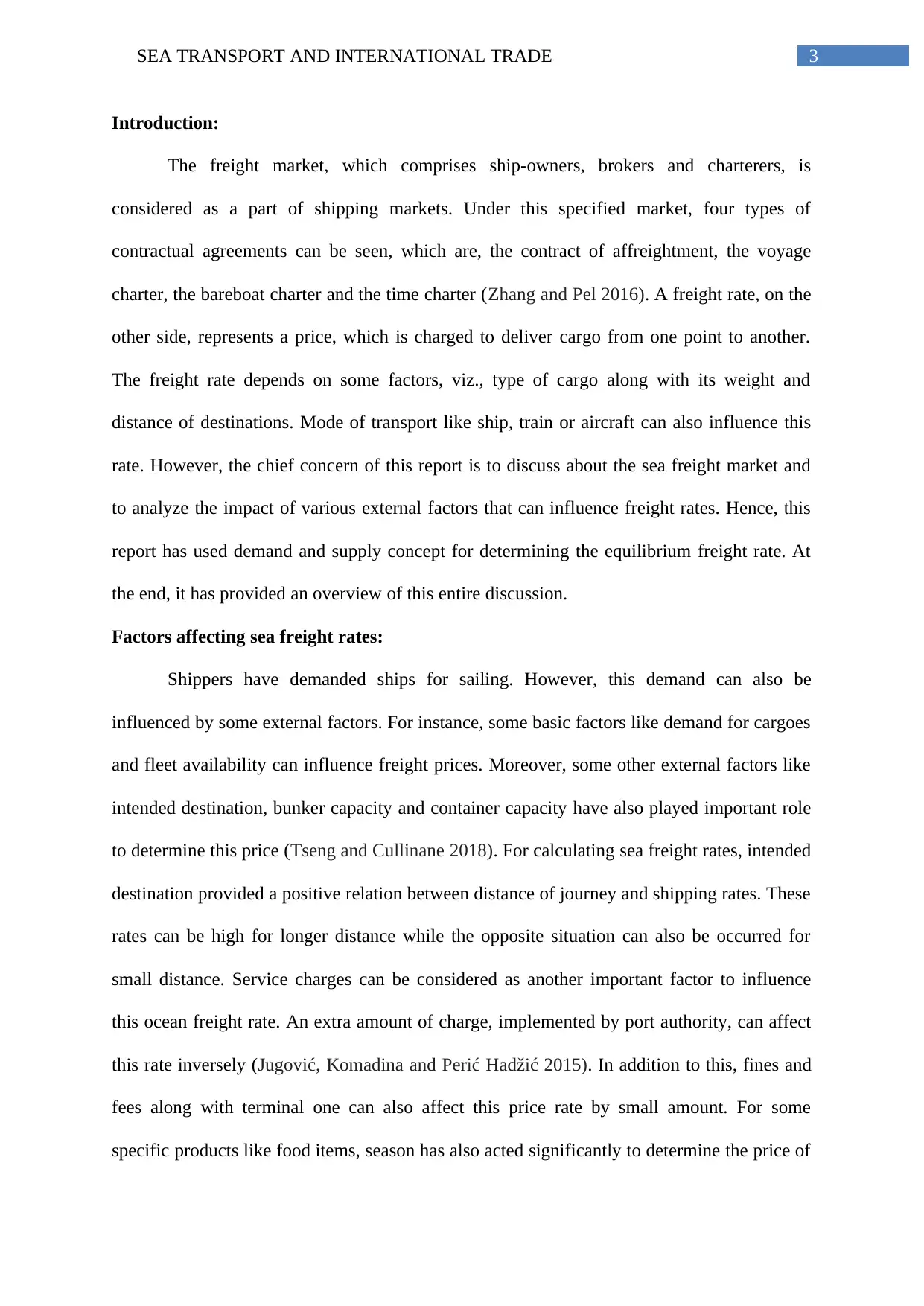
3SEA TRANSPORT AND INTERNATIONAL TRADE
Introduction:
The freight market, which comprises ship-owners, brokers and charterers, is
considered as a part of shipping markets. Under this specified market, four types of
contractual agreements can be seen, which are, the contract of affreightment, the voyage
charter, the bareboat charter and the time charter (Zhang and Pel 2016). A freight rate, on the
other side, represents a price, which is charged to deliver cargo from one point to another.
The freight rate depends on some factors, viz., type of cargo along with its weight and
distance of destinations. Mode of transport like ship, train or aircraft can also influence this
rate. However, the chief concern of this report is to discuss about the sea freight market and
to analyze the impact of various external factors that can influence freight rates. Hence, this
report has used demand and supply concept for determining the equilibrium freight rate. At
the end, it has provided an overview of this entire discussion.
Factors affecting sea freight rates:
Shippers have demanded ships for sailing. However, this demand can also be
influenced by some external factors. For instance, some basic factors like demand for cargoes
and fleet availability can influence freight prices. Moreover, some other external factors like
intended destination, bunker capacity and container capacity have also played important role
to determine this price (Tseng and Cullinane 2018). For calculating sea freight rates, intended
destination provided a positive relation between distance of journey and shipping rates. These
rates can be high for longer distance while the opposite situation can also be occurred for
small distance. Service charges can be considered as another important factor to influence
this ocean freight rate. An extra amount of charge, implemented by port authority, can affect
this rate inversely (Jugović, Komadina and Perić Hadžić 2015). In addition to this, fines and
fees along with terminal one can also affect this price rate by small amount. For some
specific products like food items, season has also acted significantly to determine the price of
Introduction:
The freight market, which comprises ship-owners, brokers and charterers, is
considered as a part of shipping markets. Under this specified market, four types of
contractual agreements can be seen, which are, the contract of affreightment, the voyage
charter, the bareboat charter and the time charter (Zhang and Pel 2016). A freight rate, on the
other side, represents a price, which is charged to deliver cargo from one point to another.
The freight rate depends on some factors, viz., type of cargo along with its weight and
distance of destinations. Mode of transport like ship, train or aircraft can also influence this
rate. However, the chief concern of this report is to discuss about the sea freight market and
to analyze the impact of various external factors that can influence freight rates. Hence, this
report has used demand and supply concept for determining the equilibrium freight rate. At
the end, it has provided an overview of this entire discussion.
Factors affecting sea freight rates:
Shippers have demanded ships for sailing. However, this demand can also be
influenced by some external factors. For instance, some basic factors like demand for cargoes
and fleet availability can influence freight prices. Moreover, some other external factors like
intended destination, bunker capacity and container capacity have also played important role
to determine this price (Tseng and Cullinane 2018). For calculating sea freight rates, intended
destination provided a positive relation between distance of journey and shipping rates. These
rates can be high for longer distance while the opposite situation can also be occurred for
small distance. Service charges can be considered as another important factor to influence
this ocean freight rate. An extra amount of charge, implemented by port authority, can affect
this rate inversely (Jugović, Komadina and Perić Hadžić 2015). In addition to this, fines and
fees along with terminal one can also affect this price rate by small amount. For some
specific products like food items, season has also acted significantly to determine the price of
Secure Best Marks with AI Grader
Need help grading? Try our AI Grader for instant feedback on your assignments.
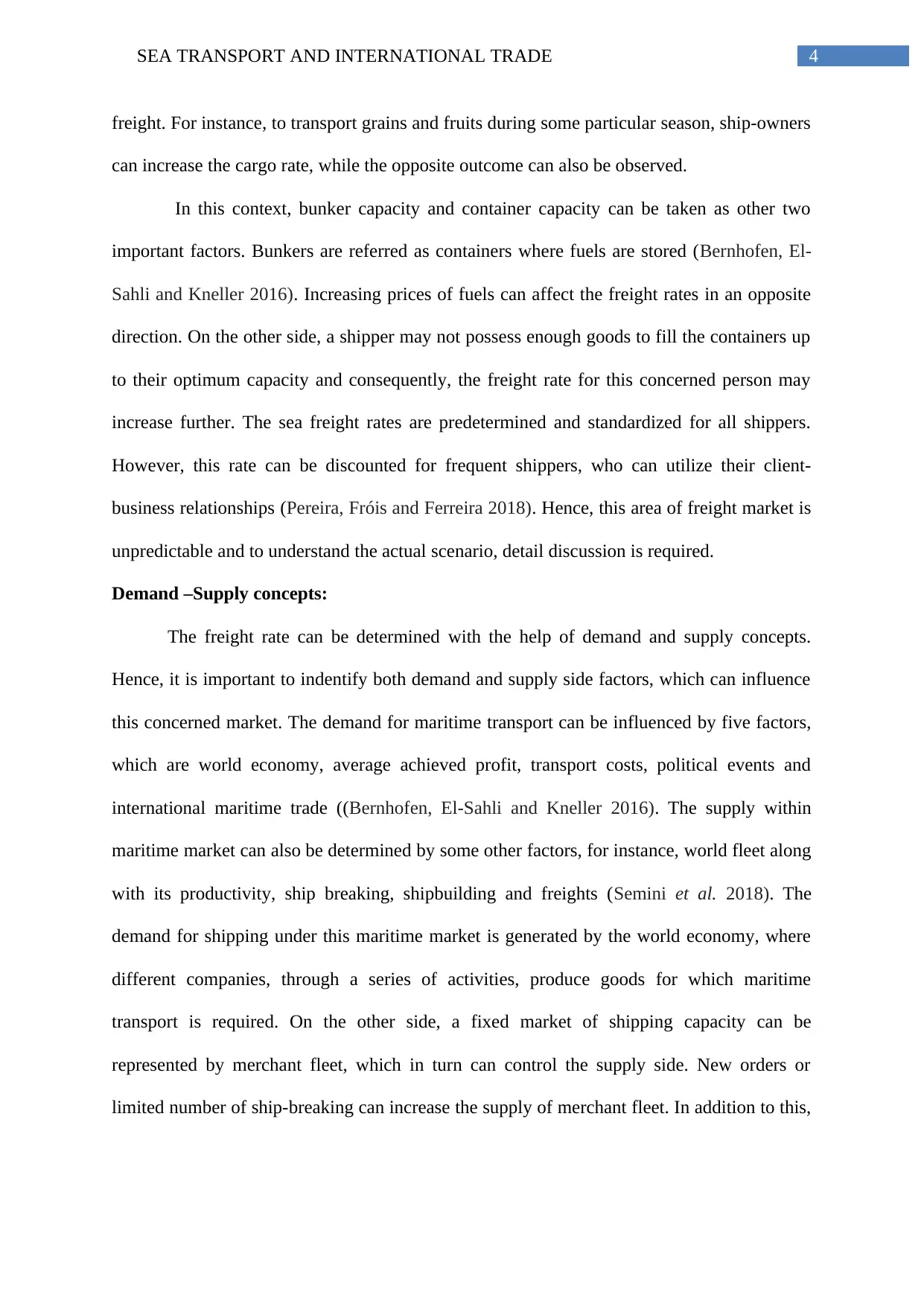
4SEA TRANSPORT AND INTERNATIONAL TRADE
freight. For instance, to transport grains and fruits during some particular season, ship-owners
can increase the cargo rate, while the opposite outcome can also be observed.
In this context, bunker capacity and container capacity can be taken as other two
important factors. Bunkers are referred as containers where fuels are stored (Bernhofen, El-
Sahli and Kneller 2016). Increasing prices of fuels can affect the freight rates in an opposite
direction. On the other side, a shipper may not possess enough goods to fill the containers up
to their optimum capacity and consequently, the freight rate for this concerned person may
increase further. The sea freight rates are predetermined and standardized for all shippers.
However, this rate can be discounted for frequent shippers, who can utilize their client-
business relationships (Pereira, Fróis and Ferreira 2018). Hence, this area of freight market is
unpredictable and to understand the actual scenario, detail discussion is required.
Demand –Supply concepts:
The freight rate can be determined with the help of demand and supply concepts.
Hence, it is important to indentify both demand and supply side factors, which can influence
this concerned market. The demand for maritime transport can be influenced by five factors,
which are world economy, average achieved profit, transport costs, political events and
international maritime trade ((Bernhofen, El-Sahli and Kneller 2016). The supply within
maritime market can also be determined by some other factors, for instance, world fleet along
with its productivity, ship breaking, shipbuilding and freights (Semini et al. 2018). The
demand for shipping under this maritime market is generated by the world economy, where
different companies, through a series of activities, produce goods for which maritime
transport is required. On the other side, a fixed market of shipping capacity can be
represented by merchant fleet, which in turn can control the supply side. New orders or
limited number of ship-breaking can increase the supply of merchant fleet. In addition to this,
freight. For instance, to transport grains and fruits during some particular season, ship-owners
can increase the cargo rate, while the opposite outcome can also be observed.
In this context, bunker capacity and container capacity can be taken as other two
important factors. Bunkers are referred as containers where fuels are stored (Bernhofen, El-
Sahli and Kneller 2016). Increasing prices of fuels can affect the freight rates in an opposite
direction. On the other side, a shipper may not possess enough goods to fill the containers up
to their optimum capacity and consequently, the freight rate for this concerned person may
increase further. The sea freight rates are predetermined and standardized for all shippers.
However, this rate can be discounted for frequent shippers, who can utilize their client-
business relationships (Pereira, Fróis and Ferreira 2018). Hence, this area of freight market is
unpredictable and to understand the actual scenario, detail discussion is required.
Demand –Supply concepts:
The freight rate can be determined with the help of demand and supply concepts.
Hence, it is important to indentify both demand and supply side factors, which can influence
this concerned market. The demand for maritime transport can be influenced by five factors,
which are world economy, average achieved profit, transport costs, political events and
international maritime trade ((Bernhofen, El-Sahli and Kneller 2016). The supply within
maritime market can also be determined by some other factors, for instance, world fleet along
with its productivity, ship breaking, shipbuilding and freights (Semini et al. 2018). The
demand for shipping under this maritime market is generated by the world economy, where
different companies, through a series of activities, produce goods for which maritime
transport is required. On the other side, a fixed market of shipping capacity can be
represented by merchant fleet, which in turn can control the supply side. New orders or
limited number of ship-breaking can increase the supply of merchant fleet. In addition to this,

5SEA TRANSPORT AND INTERNATIONAL TRADE
Freight rate
Supply of sea transport
O
A
S
policies of shippers and legal regulators can influence this supply to develop further within
this market.
After the above discussion, it is essential to understand the way by which demand and
supply operate their functions. Within this maritime market, shipowners act as suppliers
while shippers can be said as customers. They negotiate with each other to determine the
level of freight rate, which in turn can help to balance between cargo and ships, available
within the market. With the help of equilibrium concept of demand and supply this
negotiation can be done (Yip 2018). For instance, excess availability of ships can lead the
freight rate to decrease while the opposite situation can also be occurred.
Figure 1: Supply function
Source: (created by author)
Figure 1 has represented the supply function of a ship. The supply curve has
represented the amount of transport, which the owner has supplied for every level of freight.
This curve has both horizontal and vertical segments to represent elastic and inelastic supply,
Freight rate
Supply of sea transport
O
A
S
policies of shippers and legal regulators can influence this supply to develop further within
this market.
After the above discussion, it is essential to understand the way by which demand and
supply operate their functions. Within this maritime market, shipowners act as suppliers
while shippers can be said as customers. They negotiate with each other to determine the
level of freight rate, which in turn can help to balance between cargo and ships, available
within the market. With the help of equilibrium concept of demand and supply this
negotiation can be done (Yip 2018). For instance, excess availability of ships can lead the
freight rate to decrease while the opposite situation can also be occurred.
Figure 1: Supply function
Source: (created by author)
Figure 1 has represented the supply function of a ship. The supply curve has
represented the amount of transport, which the owner has supplied for every level of freight.
This curve has both horizontal and vertical segments to represent elastic and inelastic supply,

6SEA TRANSPORT AND INTERNATIONAL TRADE
Freight rate
Demand for sea transport
O
D
respectively. The ship-owners have decommissioned their ship for restricting transport below
level A. however, above the level A; shipowners have commissioned the ship again. At this
level, the ship sails at a slower rate to save fuel. However, at higher levels of freight, the ship
sails at a higher speed (Goulielmos 2018). The supply curve can be obtained under a perfectly
competitive market, where the ship-owner, through sailing at the speed of marginal cost, tries
to maximize the profit. thus, the shape of this supply function is derived from the relation of
speed and freight.
Figure 2: Demand function
Source: (created by author)
The demand function of this maritime market is drawn in figure 2. The inelastic
nature of this demand curve can be explained with some economic concepts. As the shipping
market has limited method of transport, the shippers demand cargo without considering
higher costs (Goulielmos 2018). On the other hand, lower prices of ships cannot attract
shippers to buy another one.
Freight rate
Demand for sea transport
O
D
respectively. The ship-owners have decommissioned their ship for restricting transport below
level A. however, above the level A; shipowners have commissioned the ship again. At this
level, the ship sails at a slower rate to save fuel. However, at higher levels of freight, the ship
sails at a higher speed (Goulielmos 2018). The supply curve can be obtained under a perfectly
competitive market, where the ship-owner, through sailing at the speed of marginal cost, tries
to maximize the profit. thus, the shape of this supply function is derived from the relation of
speed and freight.
Figure 2: Demand function
Source: (created by author)
The demand function of this maritime market is drawn in figure 2. The inelastic
nature of this demand curve can be explained with some economic concepts. As the shipping
market has limited method of transport, the shippers demand cargo without considering
higher costs (Goulielmos 2018). On the other hand, lower prices of ships cannot attract
shippers to buy another one.
Paraphrase This Document
Need a fresh take? Get an instant paraphrase of this document with our AI Paraphraser
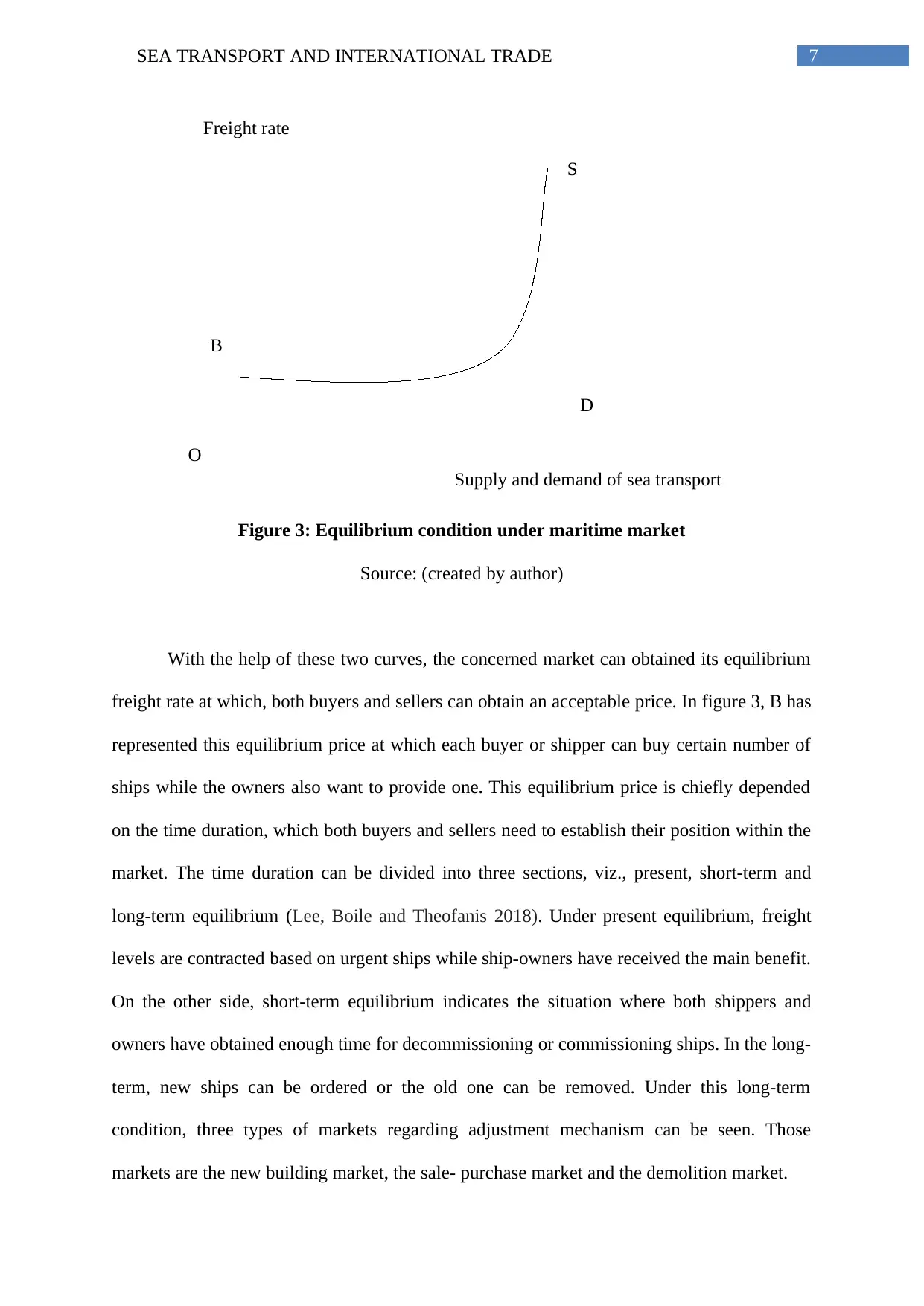
7SEA TRANSPORT AND INTERNATIONAL TRADE
Freight rate
Supply and demand of sea transport
O
B
S
D
Figure 3: Equilibrium condition under maritime market
Source: (created by author)
With the help of these two curves, the concerned market can obtained its equilibrium
freight rate at which, both buyers and sellers can obtain an acceptable price. In figure 3, B has
represented this equilibrium price at which each buyer or shipper can buy certain number of
ships while the owners also want to provide one. This equilibrium price is chiefly depended
on the time duration, which both buyers and sellers need to establish their position within the
market. The time duration can be divided into three sections, viz., present, short-term and
long-term equilibrium (Lee, Boile and Theofanis 2018). Under present equilibrium, freight
levels are contracted based on urgent ships while ship-owners have received the main benefit.
On the other side, short-term equilibrium indicates the situation where both shippers and
owners have obtained enough time for decommissioning or commissioning ships. In the long-
term, new ships can be ordered or the old one can be removed. Under this long-term
condition, three types of markets regarding adjustment mechanism can be seen. Those
markets are the new building market, the sale- purchase market and the demolition market.
Freight rate
Supply and demand of sea transport
O
B
S
D
Figure 3: Equilibrium condition under maritime market
Source: (created by author)
With the help of these two curves, the concerned market can obtained its equilibrium
freight rate at which, both buyers and sellers can obtain an acceptable price. In figure 3, B has
represented this equilibrium price at which each buyer or shipper can buy certain number of
ships while the owners also want to provide one. This equilibrium price is chiefly depended
on the time duration, which both buyers and sellers need to establish their position within the
market. The time duration can be divided into three sections, viz., present, short-term and
long-term equilibrium (Lee, Boile and Theofanis 2018). Under present equilibrium, freight
levels are contracted based on urgent ships while ship-owners have received the main benefit.
On the other side, short-term equilibrium indicates the situation where both shippers and
owners have obtained enough time for decommissioning or commissioning ships. In the long-
term, new ships can be ordered or the old one can be removed. Under this long-term
condition, three types of markets regarding adjustment mechanism can be seen. Those
markets are the new building market, the sale- purchase market and the demolition market.
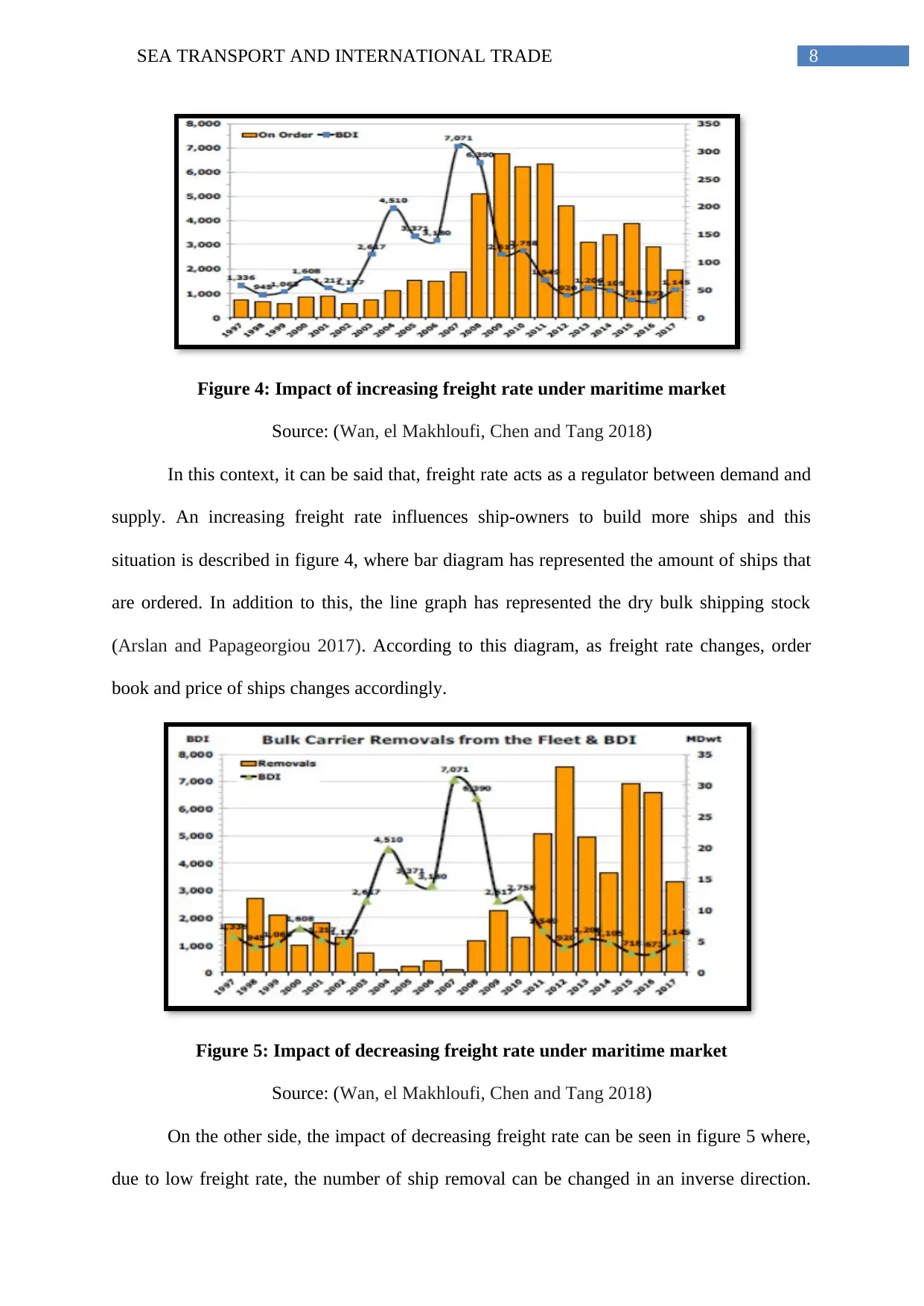
8SEA TRANSPORT AND INTERNATIONAL TRADE
Figure 4: Impact of increasing freight rate under maritime market
Source: (Wan, el Makhloufi, Chen and Tang 2018)
In this context, it can be said that, freight rate acts as a regulator between demand and
supply. An increasing freight rate influences ship-owners to build more ships and this
situation is described in figure 4, where bar diagram has represented the amount of ships that
are ordered. In addition to this, the line graph has represented the dry bulk shipping stock
(Arslan and Papageorgiou 2017). According to this diagram, as freight rate changes, order
book and price of ships changes accordingly.
Figure 5: Impact of decreasing freight rate under maritime market
Source: (Wan, el Makhloufi, Chen and Tang 2018)
On the other side, the impact of decreasing freight rate can be seen in figure 5 where,
due to low freight rate, the number of ship removal can be changed in an inverse direction.
Figure 4: Impact of increasing freight rate under maritime market
Source: (Wan, el Makhloufi, Chen and Tang 2018)
In this context, it can be said that, freight rate acts as a regulator between demand and
supply. An increasing freight rate influences ship-owners to build more ships and this
situation is described in figure 4, where bar diagram has represented the amount of ships that
are ordered. In addition to this, the line graph has represented the dry bulk shipping stock
(Arslan and Papageorgiou 2017). According to this diagram, as freight rate changes, order
book and price of ships changes accordingly.
Figure 5: Impact of decreasing freight rate under maritime market
Source: (Wan, el Makhloufi, Chen and Tang 2018)
On the other side, the impact of decreasing freight rate can be seen in figure 5 where,
due to low freight rate, the number of ship removal can be changed in an inverse direction.
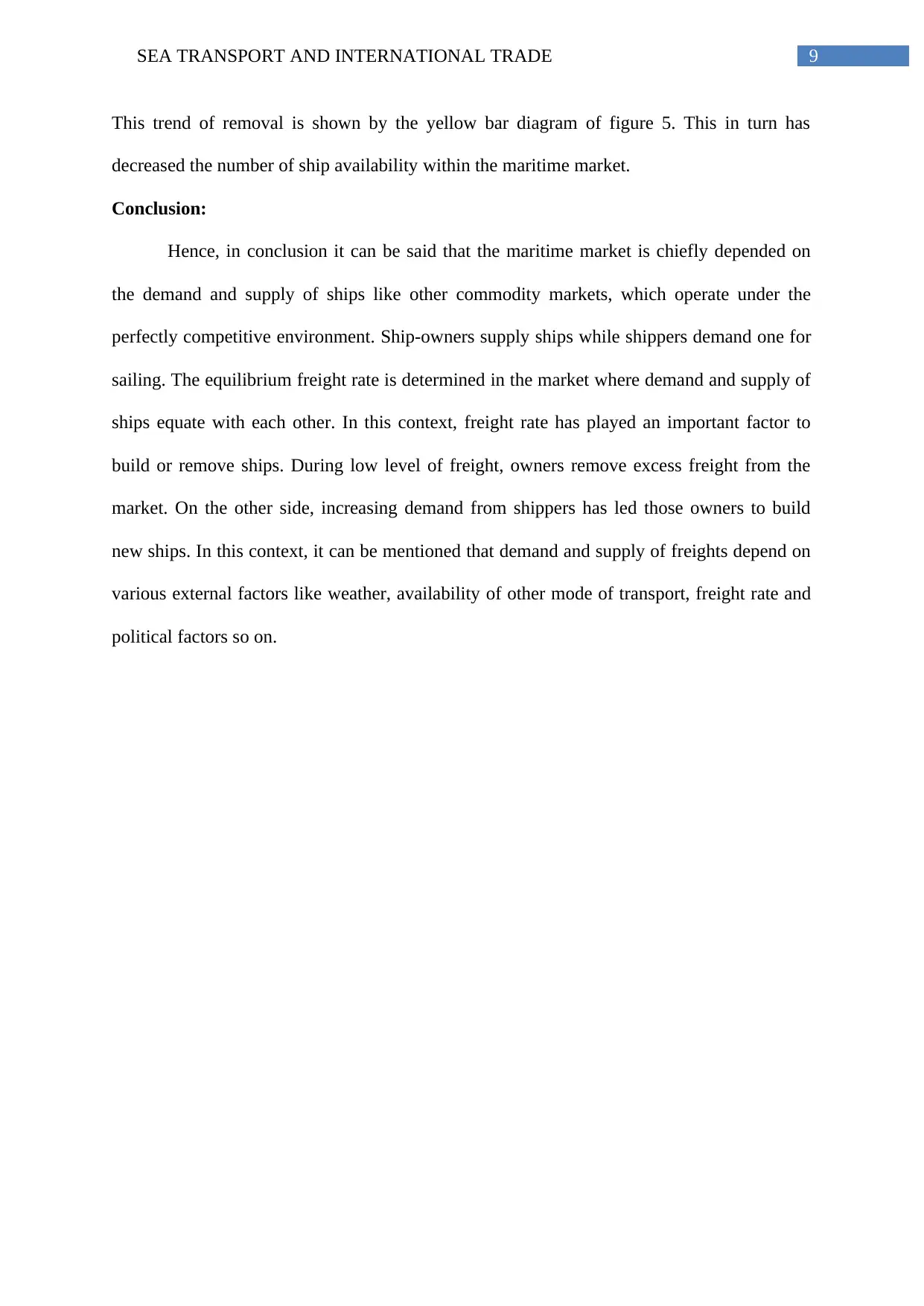
9SEA TRANSPORT AND INTERNATIONAL TRADE
This trend of removal is shown by the yellow bar diagram of figure 5. This in turn has
decreased the number of ship availability within the maritime market.
Conclusion:
Hence, in conclusion it can be said that the maritime market is chiefly depended on
the demand and supply of ships like other commodity markets, which operate under the
perfectly competitive environment. Ship-owners supply ships while shippers demand one for
sailing. The equilibrium freight rate is determined in the market where demand and supply of
ships equate with each other. In this context, freight rate has played an important factor to
build or remove ships. During low level of freight, owners remove excess freight from the
market. On the other side, increasing demand from shippers has led those owners to build
new ships. In this context, it can be mentioned that demand and supply of freights depend on
various external factors like weather, availability of other mode of transport, freight rate and
political factors so on.
This trend of removal is shown by the yellow bar diagram of figure 5. This in turn has
decreased the number of ship availability within the maritime market.
Conclusion:
Hence, in conclusion it can be said that the maritime market is chiefly depended on
the demand and supply of ships like other commodity markets, which operate under the
perfectly competitive environment. Ship-owners supply ships while shippers demand one for
sailing. The equilibrium freight rate is determined in the market where demand and supply of
ships equate with each other. In this context, freight rate has played an important factor to
build or remove ships. During low level of freight, owners remove excess freight from the
market. On the other side, increasing demand from shippers has led those owners to build
new ships. In this context, it can be mentioned that demand and supply of freights depend on
various external factors like weather, availability of other mode of transport, freight rate and
political factors so on.
Secure Best Marks with AI Grader
Need help grading? Try our AI Grader for instant feedback on your assignments.
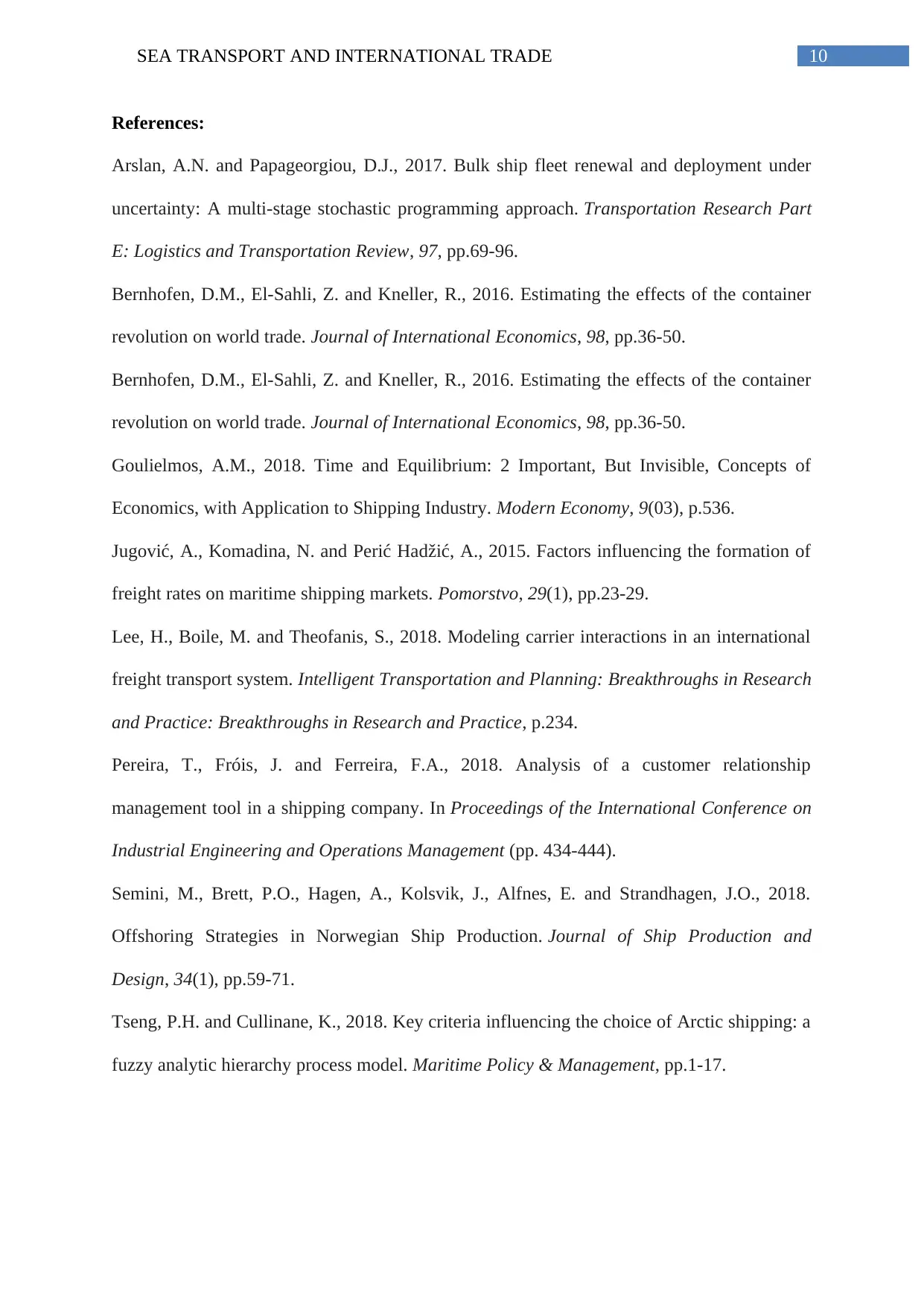
10SEA TRANSPORT AND INTERNATIONAL TRADE
References:
Arslan, A.N. and Papageorgiou, D.J., 2017. Bulk ship fleet renewal and deployment under
uncertainty: A multi-stage stochastic programming approach. Transportation Research Part
E: Logistics and Transportation Review, 97, pp.69-96.
Bernhofen, D.M., El-Sahli, Z. and Kneller, R., 2016. Estimating the effects of the container
revolution on world trade. Journal of International Economics, 98, pp.36-50.
Bernhofen, D.M., El-Sahli, Z. and Kneller, R., 2016. Estimating the effects of the container
revolution on world trade. Journal of International Economics, 98, pp.36-50.
Goulielmos, A.M., 2018. Time and Equilibrium: 2 Important, But Invisible, Concepts of
Economics, with Application to Shipping Industry. Modern Economy, 9(03), p.536.
Jugović, A., Komadina, N. and Perić Hadžić, A., 2015. Factors influencing the formation of
freight rates on maritime shipping markets. Pomorstvo, 29(1), pp.23-29.
Lee, H., Boile, M. and Theofanis, S., 2018. Modeling carrier interactions in an international
freight transport system. Intelligent Transportation and Planning: Breakthroughs in Research
and Practice: Breakthroughs in Research and Practice, p.234.
Pereira, T., Fróis, J. and Ferreira, F.A., 2018. Analysis of a customer relationship
management tool in a shipping company. In Proceedings of the International Conference on
Industrial Engineering and Operations Management (pp. 434-444).
Semini, M., Brett, P.O., Hagen, A., Kolsvik, J., Alfnes, E. and Strandhagen, J.O., 2018.
Offshoring Strategies in Norwegian Ship Production. Journal of Ship Production and
Design, 34(1), pp.59-71.
Tseng, P.H. and Cullinane, K., 2018. Key criteria influencing the choice of Arctic shipping: a
fuzzy analytic hierarchy process model. Maritime Policy & Management, pp.1-17.
References:
Arslan, A.N. and Papageorgiou, D.J., 2017. Bulk ship fleet renewal and deployment under
uncertainty: A multi-stage stochastic programming approach. Transportation Research Part
E: Logistics and Transportation Review, 97, pp.69-96.
Bernhofen, D.M., El-Sahli, Z. and Kneller, R., 2016. Estimating the effects of the container
revolution on world trade. Journal of International Economics, 98, pp.36-50.
Bernhofen, D.M., El-Sahli, Z. and Kneller, R., 2016. Estimating the effects of the container
revolution on world trade. Journal of International Economics, 98, pp.36-50.
Goulielmos, A.M., 2018. Time and Equilibrium: 2 Important, But Invisible, Concepts of
Economics, with Application to Shipping Industry. Modern Economy, 9(03), p.536.
Jugović, A., Komadina, N. and Perić Hadžić, A., 2015. Factors influencing the formation of
freight rates on maritime shipping markets. Pomorstvo, 29(1), pp.23-29.
Lee, H., Boile, M. and Theofanis, S., 2018. Modeling carrier interactions in an international
freight transport system. Intelligent Transportation and Planning: Breakthroughs in Research
and Practice: Breakthroughs in Research and Practice, p.234.
Pereira, T., Fróis, J. and Ferreira, F.A., 2018. Analysis of a customer relationship
management tool in a shipping company. In Proceedings of the International Conference on
Industrial Engineering and Operations Management (pp. 434-444).
Semini, M., Brett, P.O., Hagen, A., Kolsvik, J., Alfnes, E. and Strandhagen, J.O., 2018.
Offshoring Strategies in Norwegian Ship Production. Journal of Ship Production and
Design, 34(1), pp.59-71.
Tseng, P.H. and Cullinane, K., 2018. Key criteria influencing the choice of Arctic shipping: a
fuzzy analytic hierarchy process model. Maritime Policy & Management, pp.1-17.
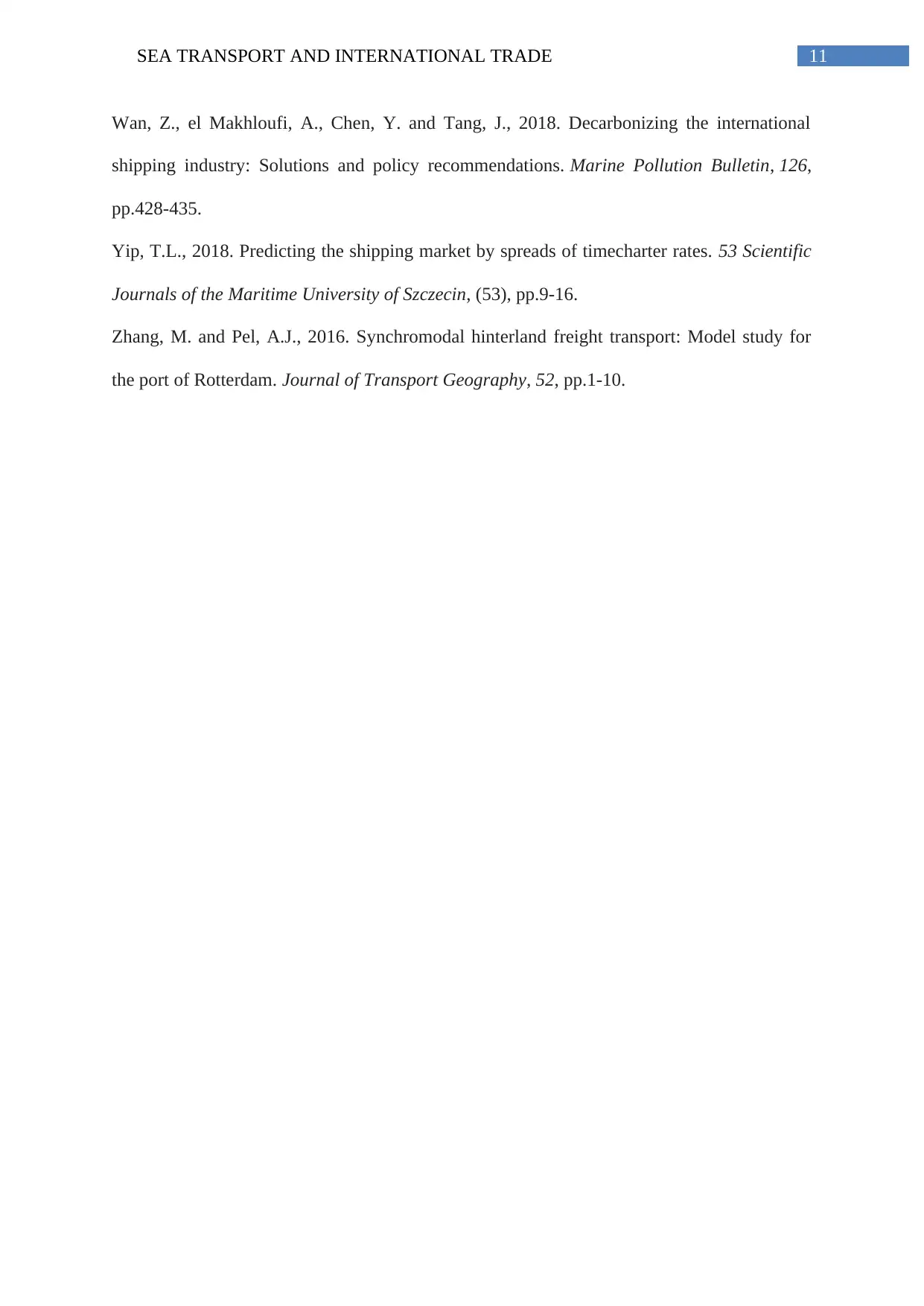
11SEA TRANSPORT AND INTERNATIONAL TRADE
Wan, Z., el Makhloufi, A., Chen, Y. and Tang, J., 2018. Decarbonizing the international
shipping industry: Solutions and policy recommendations. Marine Pollution Bulletin, 126,
pp.428-435.
Yip, T.L., 2018. Predicting the shipping market by spreads of timecharter rates. 53 Scientific
Journals of the Maritime University of Szczecin, (53), pp.9-16.
Zhang, M. and Pel, A.J., 2016. Synchromodal hinterland freight transport: Model study for
the port of Rotterdam. Journal of Transport Geography, 52, pp.1-10.
Wan, Z., el Makhloufi, A., Chen, Y. and Tang, J., 2018. Decarbonizing the international
shipping industry: Solutions and policy recommendations. Marine Pollution Bulletin, 126,
pp.428-435.
Yip, T.L., 2018. Predicting the shipping market by spreads of timecharter rates. 53 Scientific
Journals of the Maritime University of Szczecin, (53), pp.9-16.
Zhang, M. and Pel, A.J., 2016. Synchromodal hinterland freight transport: Model study for
the port of Rotterdam. Journal of Transport Geography, 52, pp.1-10.
1 out of 12
Related Documents
Your All-in-One AI-Powered Toolkit for Academic Success.
+13062052269
info@desklib.com
Available 24*7 on WhatsApp / Email
![[object Object]](/_next/static/media/star-bottom.7253800d.svg)
Unlock your academic potential
© 2024 | Zucol Services PVT LTD | All rights reserved.





